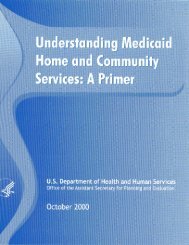STRATEGIC PLAN - ASPE - U.S. Department of Health and Human ...
STRATEGIC PLAN - ASPE - U.S. Department of Health and Human ...
STRATEGIC PLAN - ASPE - U.S. Department of Health and Human ...
You also want an ePaper? Increase the reach of your titles
YUMPU automatically turns print PDFs into web optimized ePapers that Google loves.
CHAPTER 3: Public <strong>Health</strong> Promotion <strong>and</strong> Protection, Disease Prevention,<strong>and</strong> Emergency PreparednessMeeting External ChallengesWithin the Public <strong>Health</strong> Promotion <strong>and</strong> Protection,Disease Prevention, <strong>and</strong> Emergency Preparedness goal,changes in population demographics, shifts in burden<strong>of</strong> disease, uncertainty related to the scope <strong>and</strong> timing<strong>of</strong> public health emergencies, <strong>and</strong> the potential threat <strong>of</strong>zoonotic diseases will significantly influence the ability<strong>of</strong> HHS to achieve the objectives related to this goal.As the Nation’s population ages, a greater proportion<strong>of</strong> Americans will be older <strong>and</strong> expected to livelonger. These shifts will result in an increased chronicdisease burden <strong>and</strong> a greater need for public healthinterventions to prevent or control these diseases. HHSwill work to mitigate these effects by promoting thetranslation <strong>of</strong> the evidence base for health promotion<strong>and</strong> disease prevention for older adults at thecommunity level. HHS also will continue to develop<strong>and</strong> implement cost-effective models to supportincreasingly frail older adults in their homes.A shifting distribution in disease burden also affects theability <strong>of</strong> HHS to achieve its public health objectives.For example, HIV-related disease <strong>and</strong> affectedpopulations will result in an expansion <strong>of</strong> the number<strong>of</strong> HIV-infected individuals who need treatment <strong>and</strong>related care. Infections in new subpopulations could bedifficult to identify, reach, <strong>and</strong> serve. HHS is developingimproved disease surveillance <strong>and</strong> outreach strategiesto identify <strong>and</strong> reach newly affected populations inthe United States. HHS also is providing assistance toservice providers in planning <strong>and</strong> capacity-buildingefforts to meet these changes.In the public health emergency preparednessarena, external factors represent both threats<strong>and</strong> opportunities. First, the unexpected scope <strong>of</strong>emergencies in terms <strong>of</strong> probability <strong>of</strong> occurrence,place, time, <strong>and</strong> type makes resource allocation <strong>and</strong>targeting a significant challenge. A hurricane can resultin significant public health consequences as HurricaneKatrina did in 2005, or may result in little or no healthimpact. A bioterrorist attack could be widespread,occur simultaneously in multiple locations, or belimited to one room in one building. HHS is addressing82 HHS Strategic Plan FY 2007-2012
















